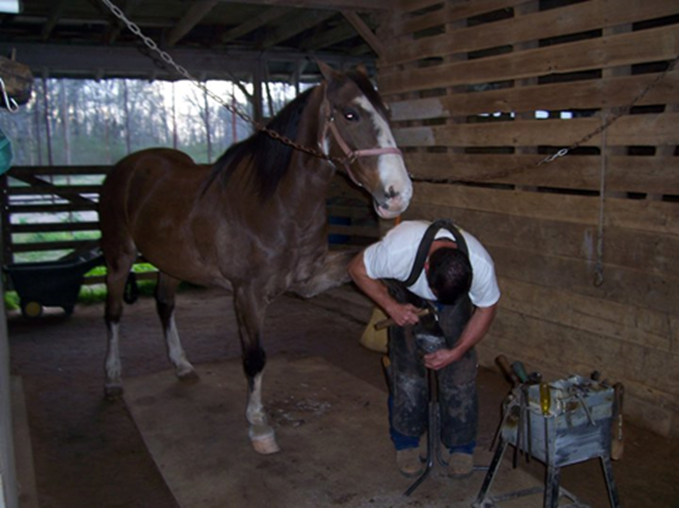
Thrush is a problem many horse owners that regularly stall their horses encounter. Credit: Amanda Masholie, Sustainable Ag & Small Farms Extension Agent, UF/IFAS Extension Walton County
Amanda Masholie, Sustainable Ag & Small Farms Extension Agent, UF/IFAS Extension Walton County
Thrush is a problem many horse owners encounter that can be a challenge as it affects overall hoof health and soundness. Thrush is a more common issue in horses which are often stabled. Keeping stalls and paddocks clean and dry helps prevent thrush from occurring. Horses that stand in bedding that is soaked in urine and wet feces can experience break down of the periople, “which is the waxy-like waterproof covering of the hoof wall that minimizes moisture evaporation from the hoof” (Lewis, Lon D. second edition, 1996). Moisture loss from the hoof can lead to softness, which after drying will leads to cracking and splitting. Standing in urine, feces, mud, or wet surfaces is the major contributor to thrush which is a bacterial infection of the sulci of the frog. “Although the specific etiological agent of thrush in horses is unknown, anaerobic bacteria are thought to play a key role.” (Beasley, Brian, DVM 2024)
Thrush can be recognized by the black necrotic material, thick black discharge from an overly soft frog that has a distinct foul odor. Thrush may affect a single foot or multiple feet. Lameness may only be present if the disease has extended into the dermal tissue. Some horses with deep sulci and narrow heels may be more susceptible to developing thrush compared to horses with wider heels and shallow sulci regardless of management and hygiene.
Treatment of thrush in horses begins with providing a clean environment for the animals to live in, along with adequate exercise. “Exercise may help clean out the hoof when the weight of the horse pushes down on the frog and surrounding hoof structures” (Beasley, Brian DVM 2024). A skilled farrier can also “remove all of the softened horn” (Belknap, James K., DVM 2019).
–
Treatment Steps
- Cleaning and Debridement:
-
- Hoof Cleaning: Thoroughly clean the hoof, use a hoof pick and brush to remove all dirt, debris, and manure.
- Debridement: A veterinarian or farrier may need to cut away soft diseased or necrotic tissue in the frog and sulci areas.
- Hoof Trimming: Trim the hoof to be balanced overall. Trim the frog to ensure it is level with the rest of the hoof, which will prevent the accumulation of debris.
- Topical Treatments:
- Disinfectants: Disinfectants can be applied to kill bacteria. Options include iodine solutions (diluted bleach, but use with caution), or commercially available thrush treatments like Thrush Buster or Kopertox.
- Astringents: Follow up with an astringent, such as tea tree oil or a product containing a low level of iodine.
- Hoof Hardeners: Use hoof hardeners to help strengthen the frog and hoof structure which will prevent future issues with thrush.
3. Advanced Treatments (if necessary):
- Prescription Medications: In severe cases, a veterinarian may prescribe antibiotics or other medications.
- Hospital Plate: A hospital plate may be applied to the hoof to protect it during the healing process.
- Tetanus Shot: If the thrush is severe, a tetanus shot may be necessary.
4. Environmental Management:
- Dry Environment: Keep the horse in a dry environment as much as possible to minimize moisture and prevent thrush.
- Clean Bedding: Use shavings or sawdust bedding instead of straw, which can hold moisture.
The old saying goes “no hoof, no horse” and there is much truth to that! Care of the feet is one of the most important aspects of equine management. Proper stall, paddock, and pasture sanitation is essential, along with routine hoof cleaning and a relationship with a professional farrier. These efforts are sure to keep your equine partner’s hooves healthy and happy.
–
References:
Lewis, Lon D. 1996 Feeding and Care of the Horse, second edition. P 178-179
Beasley, Brian DVM 2024 Thrush in Horses, Merck Veterinary Manual. Professional version.
Belknap, James K. DVM 2024 Disorders of the Foot in Horses, Merk Veterinary Manual.Pet owner version.
- Considerations for Horse Owners Responding to Recent EHV-1 Outbreak - November 21, 2025
- Agricultural Conservation Easement Webinar – December 4 - November 21, 2025
- Equine Health Alert: Mosquito-Borne Viruses Are Concerning To Florida Horses - September 12, 2025
